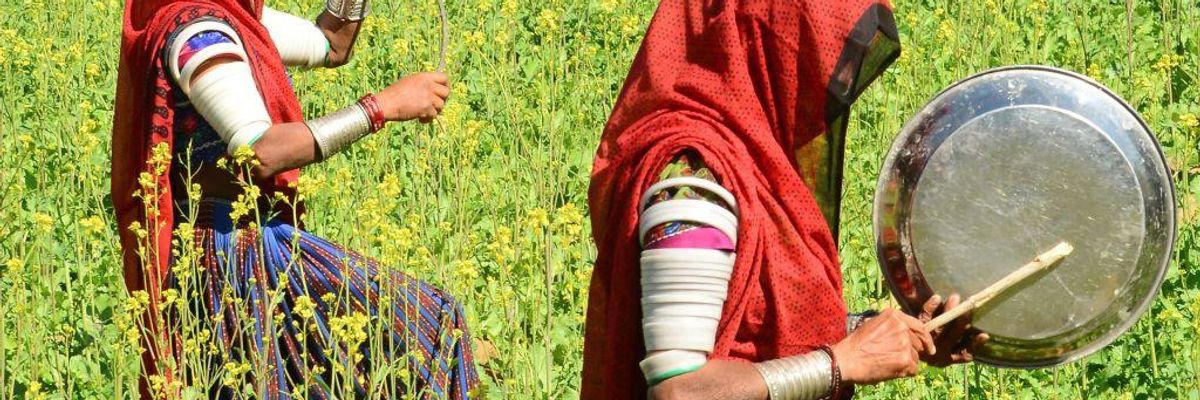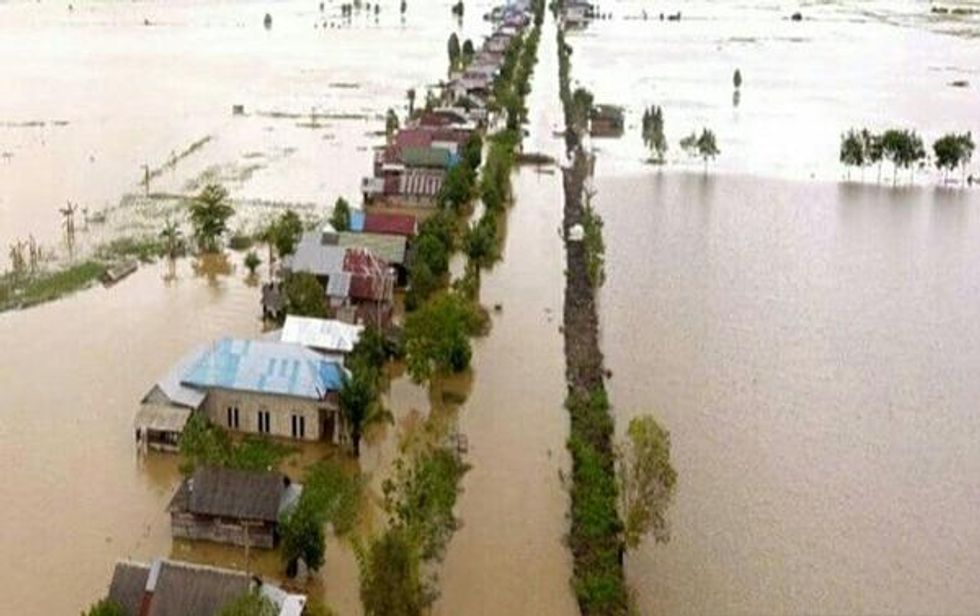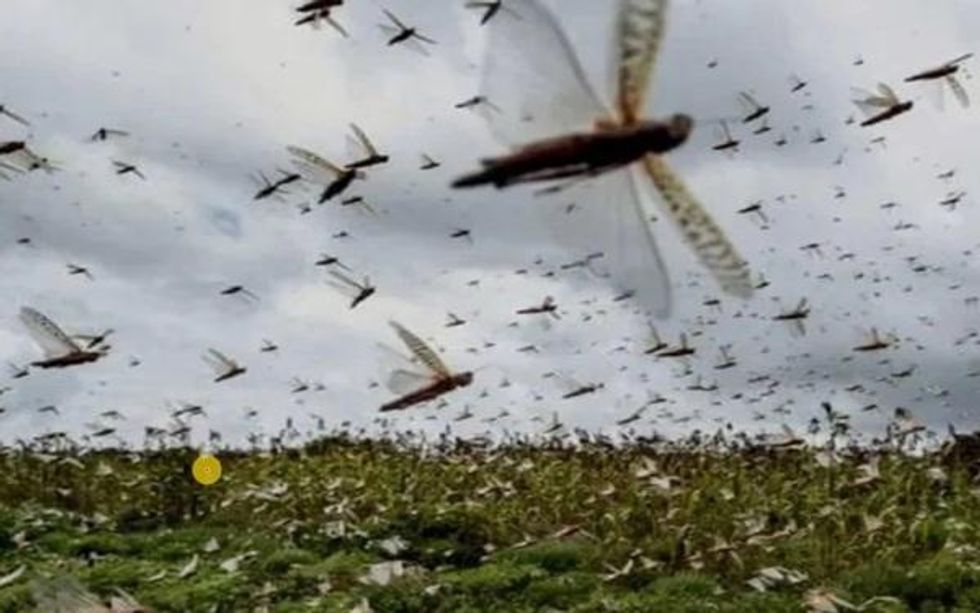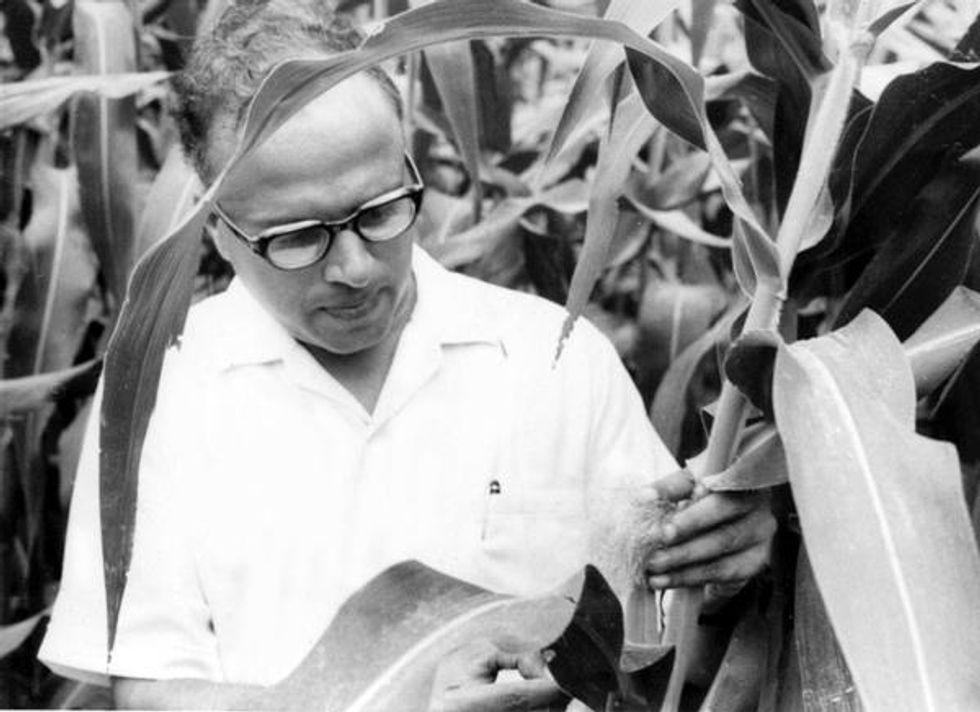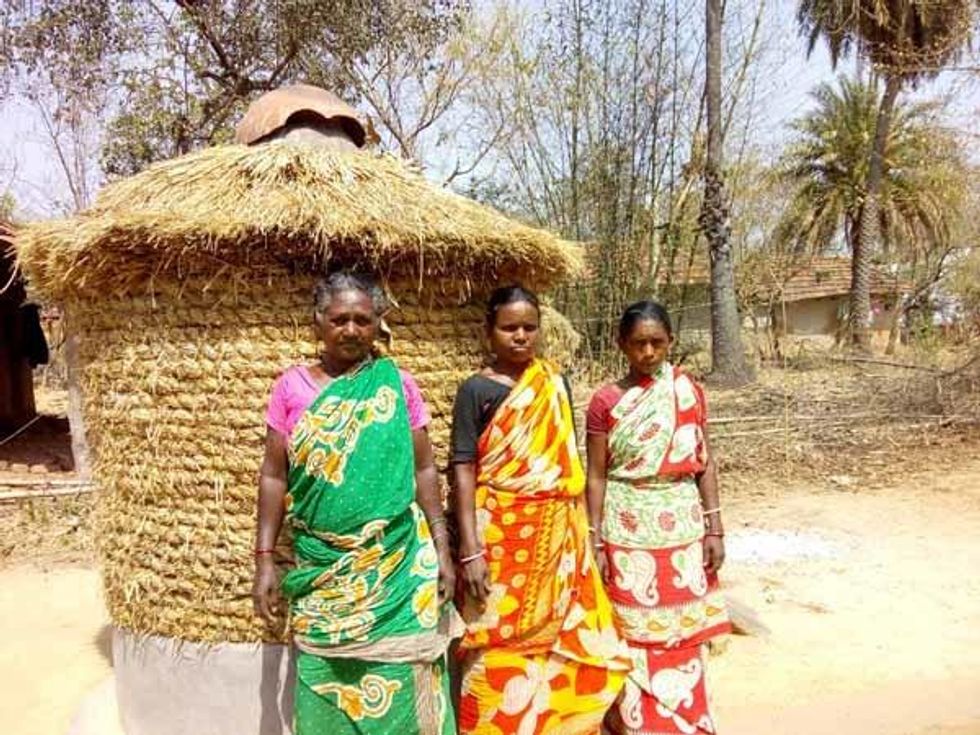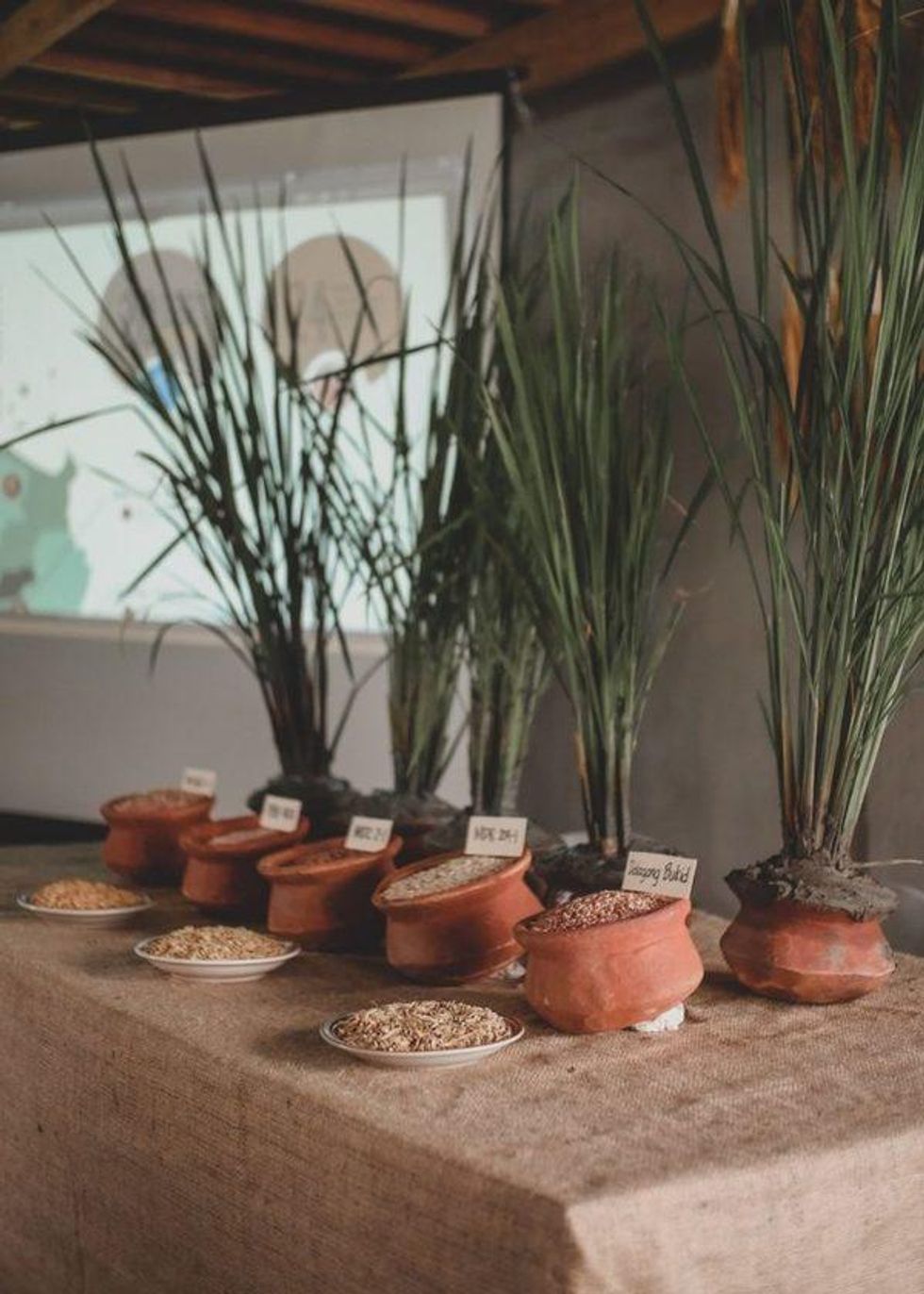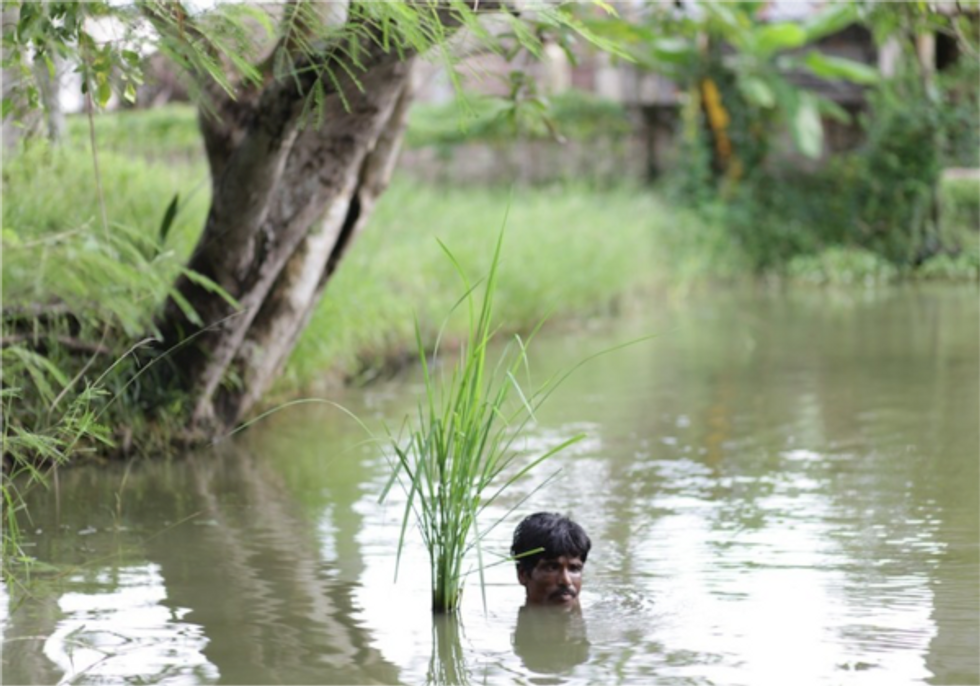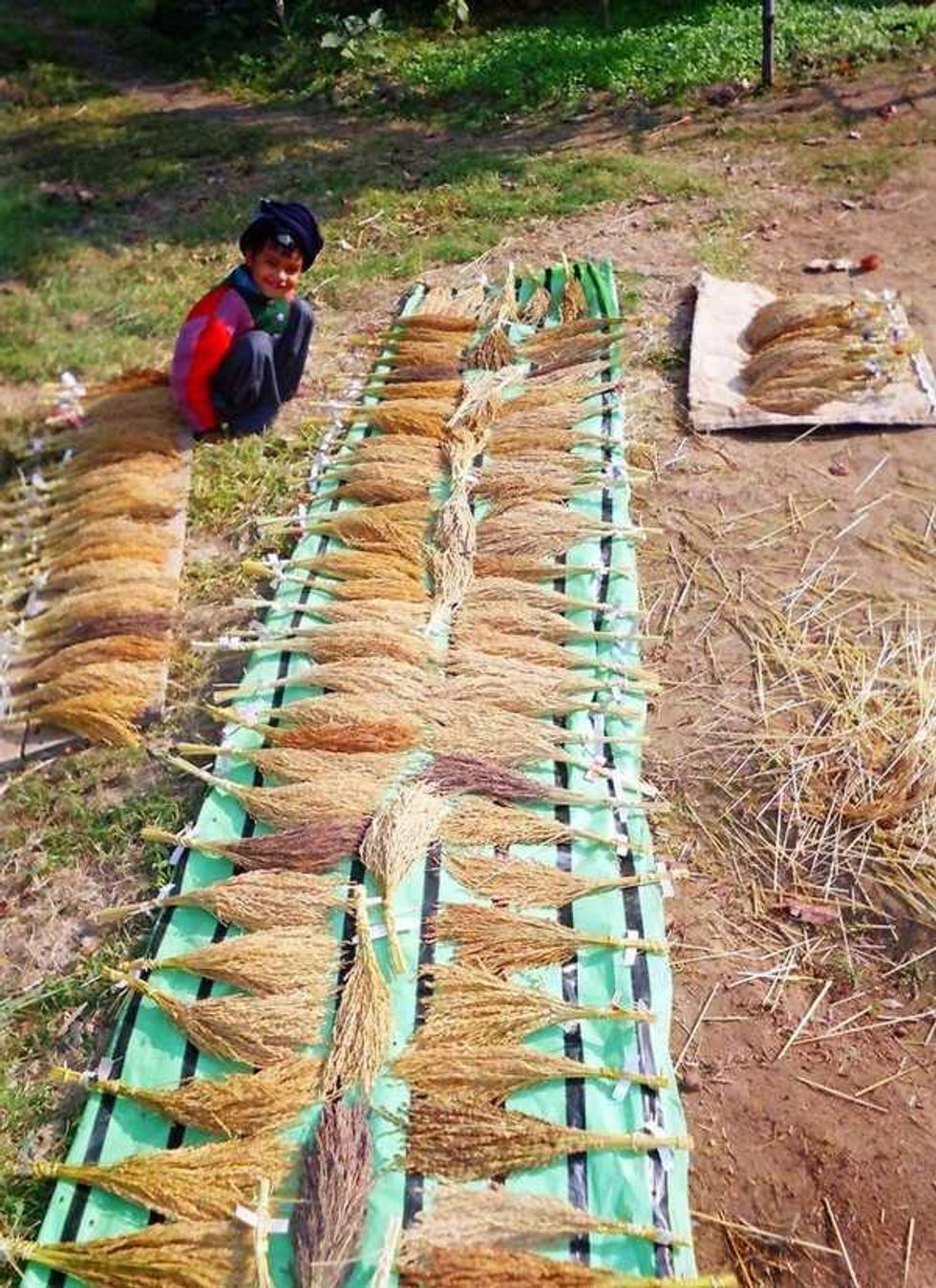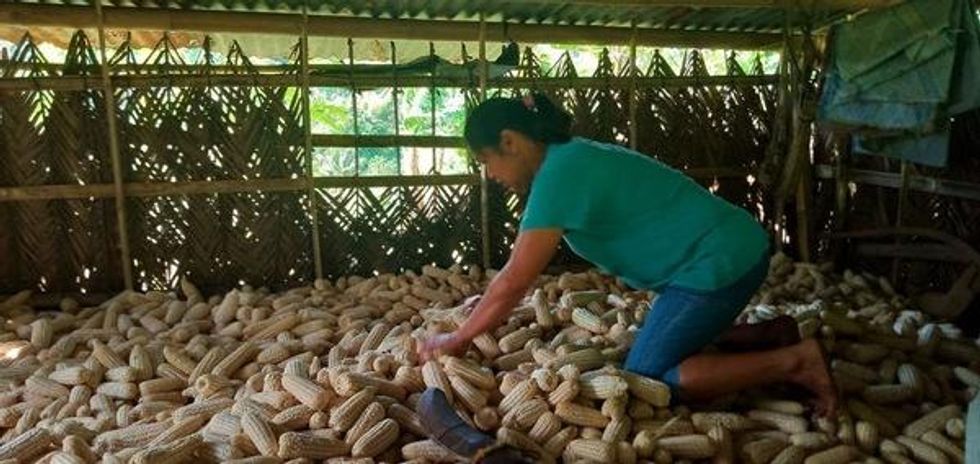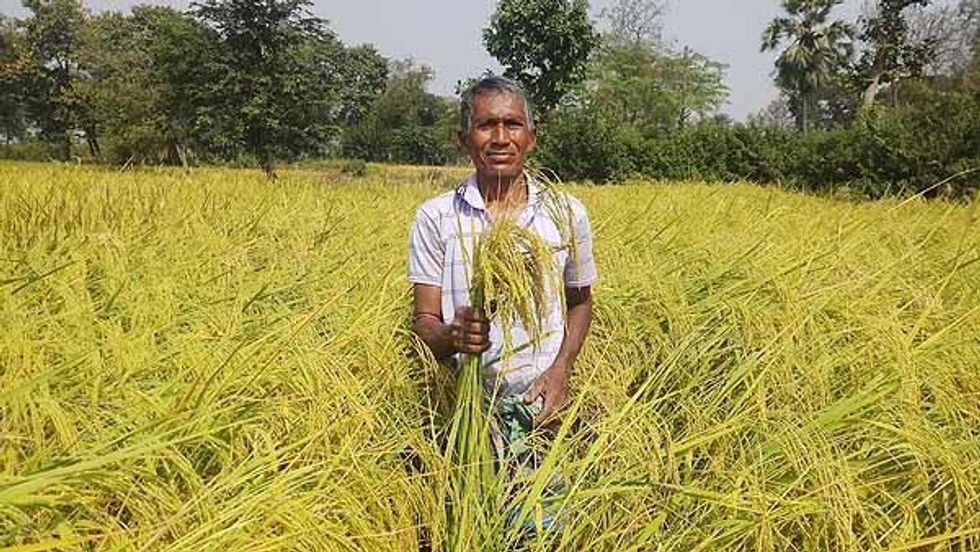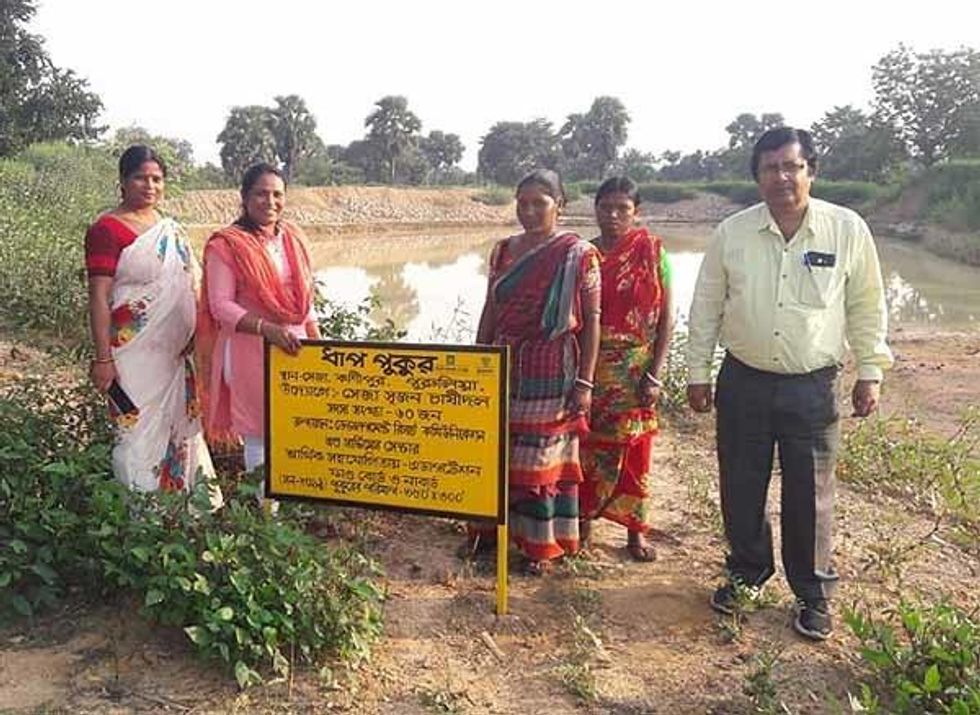As natural disasters multiply across the world, the race to fix our broken climate is proclaimed far and wide. Climate change turns up on the agenda of most international fora. And for no small reason: weather and natural disasters directly related to the climate crisis caused USD $232 billion of economic losses across the world in 2019. Asia and Oceania alone accounted for nearly half of that total, with USD $107 billion in losses. But, as urgent as the situation is, some of the solutions to the climate crisis being promoted from above are misleading. Not only are they not putting us in the right track, they are also exacerbating an array of other problems ranging from poverty to loss of biodiversity--but bringing financial gains to privileged corporate sectors along the way. Climate Smart Agriculture is one such example.
Fortunately, a number of farmers across Asia, on the front lines of climate disaster for the last several years, are putting forth a solution that is working and that is also adapted to their socioeconomic circumstances and farming traditions. Their approach is withstanding climate change, minimising greenhouse gas (GHG) emissions and strengthening their communities. Here we want to explore their experiences, highlighting how food systems based on agroecology and biodiversity from across Asia hold the key to successfully taking on climate change.
Climate breakdown and its impact in Asia
Agriculture is very climate dependent. When the climate changes, it disturbs ecosystem. Changes in temperature, precipitation, and sunlight affect the condition of arable land, livestock and water sources. In a domino effect, changes in the climate set off a chain of events that alter anything from flowering and harvesting seasons to the moisture balance in farmland, as well as the intensity of pest attacks. An increase in temperature alters underground water levels, water temperature, and ground water quality. All this impacts the quantity and quality of food production, which, at its turn impacts the rural economy, the income of producer households as well as the revenue of entire nations. For example, in India, it's Economic Survey has cautioned that climate change could reduce annual agricultural incomes in the range of 15% to 18% on an average, and up to 25% for unirrigated areas.
Beyond India, Asia as a region is expected to be one of the hardest hit in the world by global warming.The Intergovernmental Panel on Climate Change (IPCC) warns that more frequent and intense heat waves in Asia will increase mortality and morbidity in vulnerable groups. While more frequent floods and droughts and their negative impact on rice farming will exacerbate rural poverty in parts of the region.
China, which feeds 20% of the world's population from only 8% of the world's arable land, has been experiencing an increasingly uneven distribution of precipitation in the water supply between the south and north of its territory and is being hit more frequently and intensively by extreme climate events.China produces 18% of the world's grains, 29% of the world's meat, and nearly 50% of the world's green vegetables, but it is also a major importer of animal feed from international markets. Climate change would not only greatly affect China's agriculture, with broad implications for its food security, but it could also shake global food prices.
No Asian country is spared from climate disasters. Food and agriculture productions have always been victims of climate vagaries in this region. In 2019, Thailand suffered a USD $657 - $821 million loss due to prolonged droughts, followed by heavy floods, in its rice growing north and northeast regions, causing a 100,000 tonne drop in rice production, almost 8% of its export. In Indonesia, the annual loss of agricultural and horticulture crops has become quite common due to untimely rains and floods. Already this year, in early January, Indonesia suffered major flooding, devastating 209,884 hectares of agricultural land in 12 districts.
For Bangladeshi farmers, the loss of crops, homes and livelihoods to cyclones and floods is not unusual. However, for them 2020 was particularly devastating. Cyclone Amphan caused agricultural losses estimated at USD $72 million in May, but then came the longest and worst flood in the last 20 years, destroying as much as USD $42 million worth of crops. Fish farmer, Abdur Rashid of the Lebubunia village in Gabura, Satkhira, lost a third of an acre of his fishpond to Amphan and again by heavy floods in August, plunging him into poverty, forcing his 3 children to quit school. Another farmer, Abdus Samad in Kalmati, Lalmonirhat had his field flooded by cyclone water. When it receded, he planted vegetables in 2 acres, but only to be later ruined by flash floods in August. He planted again. Another flood in October washed this and the rest of his investments away. As a whole, the Bangladesh fish industry suffered a loss of USD$ 2.89 million from Amphan and USD $56.4 million due to rains and floods in 2020.

India's climate disaster story is quite similar. According to its Parliamentary Standing Committee on Agriculture, losses due to the climate crisis are to the tune of 4-9% of the agricultural economy each year, which is an overall GDP loss of 1.5%.
Hailstorms followed by heavy rains are quite common to northern India and Pakistan, but they are now also striking drought prone regions like Maharashtra and Telengana at the peak of their summer season. In April 2019, hail struck Latur in Maharashtra. According to a local farmer, Gunwant, the "hailstorm couldn't have lasted more than 18-20 minutes. But the trees had fallen off, dead birds were scattered around and the livestock was badly injured." The arid prone regions of Telengana had a similar experience in April 2020, with losses affecting 16,800 hectares of millet crop. Farmers in Pakistan are facing similar erratic climate events, with severe damage to their standing crops. Climate change is also sparking unprecedented locust attacks, like the one that thrashed Pakistani agriculture in 2020. The swarm ended up causing USD $2.2 billion worth of losses for Rabi (winter) crops and nearly $2.89 billion for Kharif (summer) crops. India and Afghanistan were not spared either. The locust attacks had serious repercussions on their food supply.

Reports indicate that climate change is also linked with the increase in farmers' suicides in India. A study by the University of California, Berkeley, shows that climate change may have contributed to the suicides of nearly 60,000 Indian farmers and farm workers over the past three decades. The damage on crops induced by fluctuations in temperature and rainfall, impact crop yield and deepen debt burden, pushing poor farmers to suicide. For temperatures above 20degC, a single day increase of 1degC causes an average of 70 suicides. Another study highlights the correlation between drought onset and suicides. It's precisely in those five states of India which have the highest percentage of drought prone areas where farmers' suicides are the highest.
Industrial agriculture and new technologies contributing to climate change
When it comes to climate change agriculture is simultaneously one of its main victims and its perpetrator. Methane is produced from rice cultivation and ruminant animals, while nitrous oxide emissions are discharged mainly from soils, fertilisers, manure and urine from grazing animals. Both these gases have considerably higher global warming potential than carbon dioxide. What often goes unsaid, however, is that most of these emissions are largely generated by industrial farming practices that rely on the heavy use of nitrogen-based fertilisers and pesticides, heavy machinery run on petrol, and highly concentrated industrial livestock operations that produce methane waste. These along with deforestation, refrigeration, and long distance transportation are all integral parts of the industrial food system.
Its dependency on fossils fuels, chemicals and on a globalised food system that is energy intensive makes of industrial farming a major contributor to climate change. Despite this, there is a push across the world to promote and expand high carbon intensive agriculture in the name of a second Green Revolution, gene revolution, and now, in the name of our climate. Encouraged by corporate interests, this new phase of industrial agriculture is based on risky technologies. On one hand, it's presenting genetically engineered (GM) crops for drought, saline or frost resistance. While on the other it offers industrial agrofuels, geo-engineering and synthetic biology. All these mechanisms and new technologies in agriculture being promoted as climate change resistant are based on large-scale mono-cropping, hi-tech investment and a chemical input system, which require big capital and centralised control. These misleading solutions to climate change are actually aimed to guarantee continued profits for corporations instead of tackling the climate crisis.
The new Green Revolution pushed in Africa, or AGRA (Alliance for a Green Revolution in Africa), with its synthetic fertiliser, hybrids seeds and monoculture farming has already demonstrated how this approach greatly undermines farmers' efforts to adapt to climate change.
False climate solutions are meant to commodify and privatise functions of nature and destroy ecosystems--forests, soil, wetlands, rivers, mangroves and oceans - upon which life depends. As we have seen in AGRA, these markets based solutions are designed to alienate local communities from their lands and natural resources. These current trends towards technology fixes have also increased the marginalisation of women in farming and have significantly impacted women's ability to earn a living for themselves and their families. Herbicides and herbicide resistance crops are being promoted in the name of zero tillage (or No-till) farming as an important component of climate smart agricultural practices. It allegedly reduces carbon dioxide emissions by sequestering more carbon in the soil, since the use of herbicides avoids plowing. However, these false solutions do not reduce emissions nor address the social crises caused by climate change, but rather allow business as usual and boost corporate profits. What's more, the women agricultural workers in India who worked weeding are losing their income.
Climate smart agriculture: Not a 'smart' solution
Climate Smart Agriculture (CSA) is being promoted by governments and corporations alike as a magic wand to deal with all climate related issues in agriculture. Showcased as something innovative, CSA is however just a rebranding and a continuation of industrial Green Revolution practices which have contributed greatly to the global climate dilemma we are in now. Perhaps to no one's surprise, the same actors who promoted the Green Revolution, like the World Bank, are now imposing CSA as a solution to climate change, with the same failed logic. In the climate negotiations, CSA was promoted as one of the eight focus areas of the Low Carbon Technology Partnerships Initiative (LCTPi) of the World Business Council for Sustainable Development (WBCSD), which brought together all the major multinational food and agriculture related corporations to influence the climate negotiations in Paris and beyond.

CSA has an inclination for genetically engineered (GM) crops, especially those that are salt, flood and frost resistant, a fact that is consistent with its predecessor's architects. Prof. MS Swaminathan, father of India's Green Revolution, affirms that "GM technology helps us to produce varieties which are climate-smart." A belief that has also been picked up by the Food and Agriculture Organisation of the United Nations (FAO), which has come out and said that biotechnologies, both low-and high-tech, can help small-scale producers, in particular, to be more resilient and to adapt better to climate change. This statement from the FAO is being hailed by GMOs defenders as an acknowledgment of "climate-smart" biotech crops.
This obsession of CSA with new technologies ignores tried and tested traditional farming techniques and indigenous seed varieties, while it creates dependency on climate smart technologies, inputs and credit. Several local initiatives exists which combine acquired-scientific-knowledge with traditional wisdom but governments in Asia have shown little interest to support them and are instead falling for false-solutions packaged as climate-smart by the corporate sector.
The same way the Green Revolution demanded the imposition of agrochemicals as a precondition to access loans and technical support, CSA is now imposing transgenics and biotechnology. Companies already notorious for provoking disastrous social impacts on farmers and communities, driving land grabbing or promoting GM seeds, are now self-proclaimed "climate-smart."
Evidence from the ground: Peasants solutions to the climate crisis
In the longest-running side-by-side comparison of organic and chemical farming system trail (FST) documented by the Rodale Institute, over 27 years of organic practices increased soil carbon by almost 30%. Soils rich in carbon conserve water and support healthier plants that are more resilient to drought stress, pests and diseases. Globally, organic agriculture could sequester nearly 40% of current CO2 emissions.
There are enough local community-based evidences which indicate that peasant-based agroecological approaches have immense mitigation and adaptation potential and can make significant contributions towards reducing GHG emissions. Agroecology uses low fossil fuel-based inputs and has a better carbon footprint than industrial agriculture-based practices. The wide array of agricultural practices that are part of agroecology which include permaculture, agro-forestry, organic farming, biodynamic farming and zero budget natural farming, make it optimal in soil carbon sequestration and thus a powerful tool to help mitigate climate-related risks.
Small farmers across the world are continuously adapting their way of living and farming, enabling them to withstand the climate breakdown and minimize GHG emissions. After experiencing climate impacts - drought, irregular rains, hailstorm, reduced monsoon and increased pest attacks--small farmers are developing their own strategies to combat the climate crisis. These include:
- water harvesting systems,
- better irrigation techniques that include drip irrigation,
- the use of traditional seeds, bio-fertilisers and bio-pesticides,
- mulching, multiple cropping and mixed cropping practices,
- gathering information on timely weather reports,
- proper planning of agricultural practices,
- biodiversity conservation and
- the increased use of solar energy.
Most of the time, they have done it so successfully that it has gone unnoticed. When locust pests swarmed India in 2020, affected state governments ordered aerial sprayers and drones to sprinkle chemicals, but small farmers had already designed their own zero fossil fuel local techniques to drive away pests, like with the use of drums and loud sound producing techniques.
As an alternative to hybrid and GMO seeds, which can perform better only with fossil fuel based chemical inputs, several seed networks conserving indigenous varieties have sprung up across South Asia and South East Asia, which offer climate resilient seeds to deal with harsh weather conditions. Seed saver networks help farmers to creatively cultivate ever more crop varieties to deal with the many different challenges of soils, climates, nutrition, flavour, storage, pests and diseases. Women farmers, in particular, play a significant role as seed savers or custodians of traditional seeds. These seeds offer strong resistance to extreme climate.
Across Asia, indigenous populations are faced with increasing climate change challenges such as disappearing animals, food and tree species, forest fragmentation, impacts of rapid development and more. However, using traditional wisdom and practices, they have developed their own local food sovereignty strategies to deal with climate change.

The Kond people of Odisha in India, for example, use agroecological practices to maintain climate resilient agrobiodiversity, allowing insects, pollinators, flies and birds to thrive on their farmlands. An indigenous women farmer, Sunamain Mambalaka, cultivates over 80 varieties of crops in her 2 hectares farm, including pearl millet and sorghum which are ideal for regions which are prone to drought and extreme heat, as well as indigenous short duration upland rice varieties, which consume less water and make them resilient to drought-like conditions. In Odisha, farmers are also practicing rice straw-based potato farming where farmers save the financial and environmental cost of stubble burning, as well as from leveling or tilling the field. Farmers plant potatoes tubers among the leftover straw and stubble after harvesting the rice, which reduces water requirement by 80%, since rice straw retains moisture for long periods, and helps as well in controlling weeds.
MASIPAG, a farmer-scientist organisation in the Philippines, has shown that mitigation and adaptation to climate change are possible through biodiversity based agroecological farming. According to MASIPAG, indigenous farming practices by small-scale subsistence farmers have proven to be healthier, cheaper and resilient to climate change. They have chosen local indigenous seed varieties that grow more quickly, resist dryness or survive in excessive waters, with water management systems developed to deal with floods and to keep soils humid during the dry season. In the last 3 decades, MASIPAG farmer communities have developed a collection of 2,000 plus rice cultivars and with its programs on rice breeding and seed improvement, it managed to identify 18 drought-tolerant varieties, 12 that are flood-tolerant, 20 salt-water tolerant and 24 that are pest and disease tolerant.

Beyond climate adaptation, MASIPAG farmers contribute in emission reduction as well, by completely banning the use of chemical fertilisers and pesticides in their rice production, thus significantly reducing carbon emission from the farm. Another important strategy being applied is to grow diversified or multi-crops and trees because they reduce the risks of total crop loss during floods, drought and saltwater intrusion caused by cyclones. This biodiverse system also provides different kind of foods at different times and other multifunctional benefits like fodder, green manure, firewood, hedge, erosion control, wildlife habitat and more. MASIPAG farmers apply this concept to grow a large number of different varieties better adapted to climatic and geographical-specific conditions. Some farmers also integrate livestock into the farming system as an alternative source of income. These agroecology-based diverse, productive and resilient farming systems put forth by MASIPAG are fundamental to maximize the adaptive capacity of farming communities to climate stresses, strengthening their unity and social fabric in the process.
Similarly, Southeast Asia Regional Initiatives for Community Empowerment (SEARICE), together with farming communities in the Philippines and Cambodia have developed community managed seed systems to make them more resilient. The SEARICE climate change adaptation programme, empowered local communities in both countries to manage rice diversity and strengthen local seed systems, all meant to increase communities' adaptation skills.
In Cambodia, SEARICE helped local communities to set up farmers' field schools and trained farmers to adapt to climate change by selecting and planting short maturing rice varieties and to grow two crops in a season if there were threats of drought. In the hilly regions of the Philippines, farmers adopted terrace farming to deal with soil erosion. In coastal areas, where seawater intrusion is common, farmers used local saline resistant rice varieties to deal with soil salinity. They managed to do this thanks to their access and control of indigenous seeds, which they learned to adapt and make more resilient to the different challenges. SEARICE has managed to conserve over 50 varieties of rice, in their community seed banks in the Philippines and Cambodia, which have proved to be quite useful in extreme climate conditions. More than 3 000 farming families had access to the crop genetic diversity. A valuable treasure for future generations for dealing with changing climate conditions.

In the meantime in India, the Basudha farm and Vrihi (Sanskrit for rice) community seed bank in Odisha, set up by Dr. Debal Deb, holds India's largest in situ selection of one crop diversity, conserving more than 1 400 rice varieties. These climate-resilient varieties are suited to every kind of climate, soil and water source and tolerant to adverse conditions. Vrihi rice seeds, collected and conserved for over 3 decades in the Basudha in-situ farm and exchanged with hundreds of farmers every year provide immense possibilities for dealing with changes in temperature and climate, differences in soil nutrients and water stresses. The Vrihi collection includes flood-resistant rice varieties which can grow taller in floodwater, while some varieties can also grow in submerged conditions. Other varieties can withstand fluctuations in rainfall timing, or thrive in highly saline soils. Diversity in the food systems is essential against the climate crisis and extreme weather patterns.
When cyclone Aila struck Sudarbans villages on the Bay of Bengal coast in 2009, Vrihi saline resistant indigenous seeds saved local farmers whose crops were destroyed and suffered from high levels of soil salinity. These varieties have such high salt tolerance that farmers cultivated them without any embankments to keep salt water out. Not only were they resistant to salinity but these varieties also provided a better yield than hybrids seeds, which farmers were growing before the cyclone hit, yielding 240-kg in less than one-tenth of a hectare of land. Some of the rice varieties in Vrihi have multiple cultural and medicinal properties as well, and some are quite rich in a range of micronutrients like iron, zinc, vitamins, and antioxidants, thus ensuring the nutritional security of the farming communities along the way.

For the last 30 years, a farmer based organisation in West Bengal, the Development Research Communication and Services Centre (DRCSC), has been developing the sustainable management of natural resources through disaster-resilient and climate-friendly models in various agroecological regions of West Bengal, which includes integrated farming. The bio-diverse integrated farming model combines at least 5-6 types of food crops, 10-12 types of vegetables, trees yielding food, fuel and fodder, and medicinal plants throughout the year. The DRCSC uses farm saved indigenous seeds, local organic fertilisers from biogas slurry and promotes multi-tier mixed cropping systems like the rice-fish-duck-azolla integrated method.
The Indian part of rural Bengal normally faces acute food scarcity twice a year, which gets worse due to droughts, floods or storms. Here the DRCSC trains farmers in several districts to preserve the village grain bank, which is kept on high land, safe from floodwater. The rice is accessible to peasants at a low interest rate which they pay on the next harvest. In Birbhum villages, farmers are encouraged to plant food fodder trees, tubers, wild vegetables and edible weeds which ensure a supply of food- for both humans and animals- when affected by floods, storms or droughts.

Back in West Bengal, faced with an increasingly deficient freshwater supply, villagers have had to transform and adapt their management of the resource. Their current approach to the cultivation of boro rice is a clear example. This crop requires large amounts of water, which is normally extracted from the ground using diesel/electric pumps. This technique, however, ends up depleting the ground water supply. Farmers have therefore adopted SRI (Systematic Rice Intensification) methods. With SRI, a single rice sapling is sown instead of in bunches, requiring a lesser amount of seeds and the rice fields do not have to be kept continuously flooded. This reduces the required amount of water, which in turn reduces GHG emissions. But in West Bengal, villagers are not stopping there. They are also harvesting rainwater. By digging ponds, villagers are able to gather enough water not only to irrigate their crops- minimising ground water pumping- but also for fish farming. The whole structure is optimised and creeper vegetables are planted on all sides of the pond. As the water level goes down, different kinds of seasonal vegetables and pulses, even boro rice, are grown. This adaptation practices has been developed to build long-term resilience to climate impacts.

Similar climate adaptation practices and strategies have been found in indigenous communities in other parts of Asia. Biodiverse multi crop cultivation in the same plot has been used for generations in Sabah, Malaysia, which minimizes the risk of crop failure due to changing weather patterns. While in Bangladesh, indigenous communities are building floating vegetable gardens or 'Baira Cultivation' in the flood prone areas of the country, while others practice the shifting cultivation method and move to new locations less susceptible to climate shifts. In Nepal, new rice varieties like Aryan and Makawanpure have been introduced that are less dependent on water. In Vietnam, farmers plants hedges on the coast to diffuse tropical storm waves. Whereas harvesting rainwater has become quite common for households and farmers in many regions of South Asia. And the climate adaptation examples across the region go on.
But can agroecology feed the world?
It is clear that the agricultural sector is being hit hard by the vagaries of nature and climate catastrophe around the world, a reality that seems to be the more threatening in several Asian countries, where large populations could be on the brink of food insecurity and hunger. A valid questions may be whether agroecology and food sovereignty-based agricultural models are capable of producing enough to feed the growing population? The response lies in the abundance of examples we highlighted above. Biodiverse and sustainable agriculture based alternatives are available in almost every region of Asia. Not only do these offer credible solutions to climate change, but these alternatives are also quite impressive in offering the right solutions to assure our food security.
With the increasing and devastating impact of climate change, more and more farmers are adopting alternative farming systems not only to make their farms more resilient to climate stress but also to cut their cost of production by avoiding the use of hybrid seeds, synthetic fertilisers and pesticides, the staples of conventional agriculture. As Chukki Nanjundaswamy, women farmer leader of Karnataka Rajya Ryot Sangha (KRRS) and founder of India's agroecology school, Amritabhoomi, said, "The impact of climate change is definitely pushing farmers to adopt agroecology or other alternative cropping systems. Today there is absolutely no lack of evidence to prove the positive impacts of agroecology, indigenous seed varieties and agro-diversity in dealing with climate stresses. It is time for governments, international institutions like FAO and agribusiness to realise the major role that peasant agroecology and food sovereignty play in dealing with climate change. It is time for them to stop promoting false technologies and false solutions like Climate Smart Agriculture."
People across Asia are mobilising to put forward real alternatives to face the climate crisis, initiatives based on their right to self-determination, community building and food sovereignty. Their example is impressive and inspiring. But, for those in high places, it shouldn't remain table talk or be treated as interesting exotic ventures. They must become a road map--in Asia and the rest of the world--to get us all out of the terrible mess created by industrial agriculture and corporate greed.
